There needs to be more clarity regarding, do you plant potatoes with the eyes up or down. Most gardeners will agree having the eyes up is the right way, but still, having the tubers facing down will also get you great, if not equal, results.
Keep reading to know the different seed potato eyes planting options and the best mode for your next bountiful harvest. Let’s get started!
Contents
When Should You Plant the Potatoes?
Like other crops, potatoes have their specific growing season, which comes with other essential aspects. Generally, you’ll have to choose the right planting season. One major factor is the ideal soil temperatures, generally at 45°F at night and 55°F in the daytime.
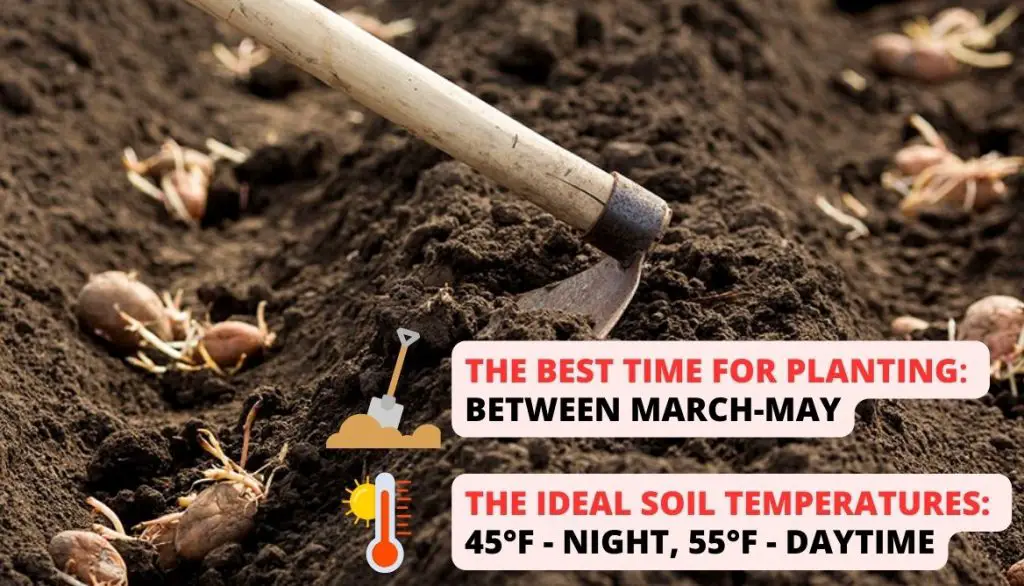
The best time is between March-May, which can depend on your region. June is also an option, especially when using containers as your farming method. However, you also should consider other factors, such as:
- Giving the land time before planting: Allow the land to have new acidic levels, preferably by planting other vegetables like carrots and tomatoes.
- Use the right seed potatoes: You should get disease-free types and those with developed eyes for easier planting and an effective growing process.
- Drain and moisture: Ensure the soil is well drained and moist.
Where are the Eyes on a Potato?
Potato eyes are buds found all over the potato’s surface.
- You’ll find them concentrated on sections where the potato has been cut or damaged.
- The eyes sprout new growth when the conditions are right, allowing the potato to reproduce.
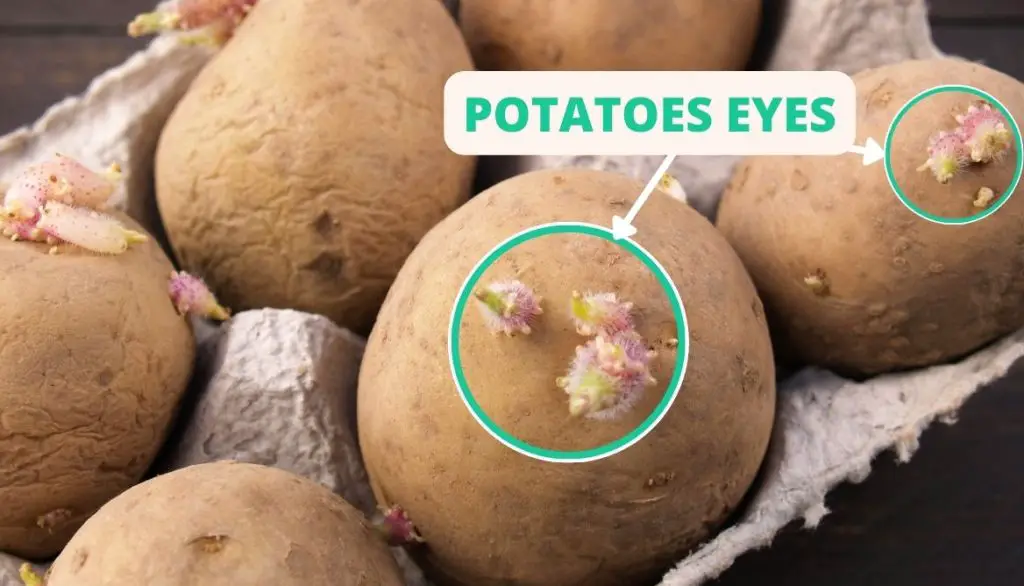
This factor explains why farmers often cut larger seed potatoes, ensuring each piece has at least one or two eyes to grow new potato plants.
Do You Plant Potatoes With the Eyes Up or Down?
Agriculturalists prescribe that your potato plants have a better chance when facing upwards. Nonetheless, seed potatoes still grow when facing down; the difference will be in the number of yields.
Here are the advantages of planting the potato tubers facing up:
- The potato plant grows more easily through the soil, promoting better root development.
- The seed potatoes can easily access natural nutrients like sunlight.
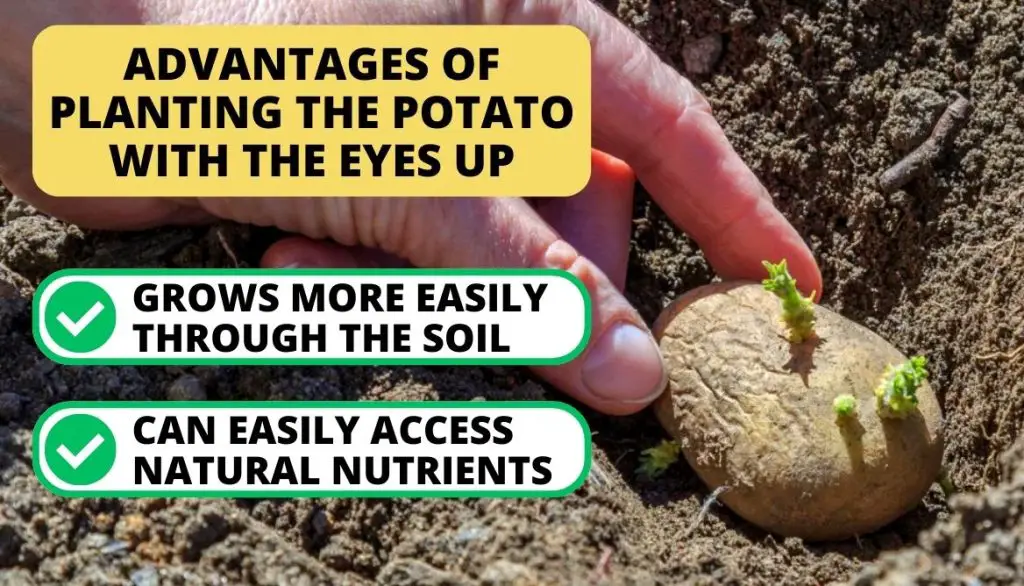
Is it Harmful to Plant with the Eyes Down?
It is not entirely harmful to plant potatoes with the eyes down. Many gardeners have reported getting good harvests. So, when can the buds face down?
- Using machinery like tractors doesn’t follow the ‘eyes up’ rule when planting potatoes.
- When the potato plants grow longer or have multiple buds, the sprout can face either direction and develop similarly to when facing upwards.
- The gardening method is also a factor where some, like straw mulch types, can accommodate the seeds facing either direction. The potatoes grow effectively, considering there isn’t much soil covering.
Therefore, you can still get good output when your plants face downwards, though first consider the mentioned factors to avoid further consequences.
Is Cutting Potatoes Before Planting Beneficial?
Cutting the seeds is a convenient way to save for your next harvest and, most importantly, get more yields from a lower investment. So, what are the advantages of dividing your more enormous seed potato?
- You get more sprouted potatoes.
- It helps inspect the specific seed potato for diseases or pests before planting.
- Smaller size varieties tend to sprout faster than larger potato pieces.
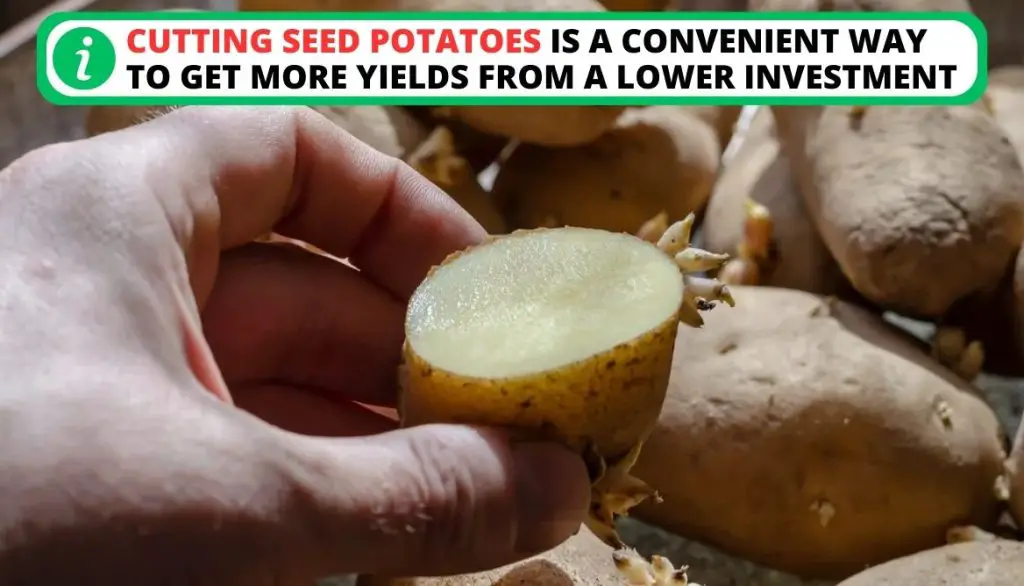
When Should You Cut Seed Potatoes?
You can cut your potatoes 2 or 3 days before the planting date. There are several steps you should follow before cutting a seed potato, and they include the following:
- Storing in the right conditions: Prepare your planting potatoes 2 or 3 weeks earlier, which includes keeping the varieties in the proper temperatures (60-70 Fahrenheit).
- Find a sharp knife to cut the seeds approximately 2″ in size, containing at least one or two eyes.
- Remember not to cut small (golf ball-size) varieties to avoid compromising your yield.
A Step-by-Step Guide to Plant Potatoes with Eye
Here’s everything you need to know and need to plant potato eyes. Also, watch this video for more information:
The Needed Tools and Materials
Let’s focus on the required equipment as you prepare for the early spring growing season. Here are the tools and materials needed, in addition to their functionality and significance.
Key Tools and Materials
The main materials required as planting resources are:
- Potato plants,
- Fertilizer,
- Organic matter like compost.
Now let’s take a look at some of the items you can bring to the garden when preparing your seed potatoes:
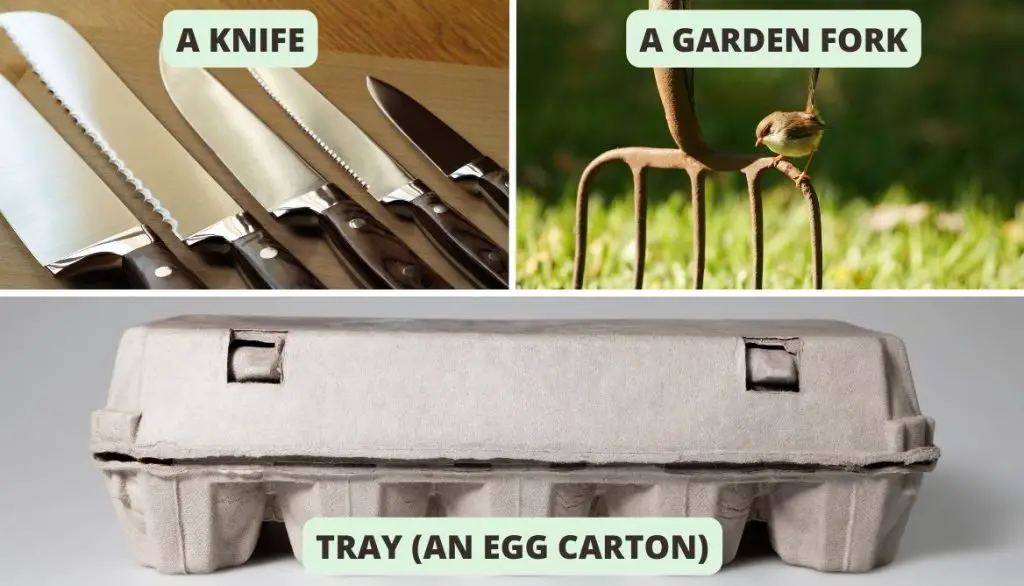
- A Knife or garden shears: These two are ideal for precise cuts.
- Tray: You can use an egg carton to store freshly cut seed potatoes as you prepare your land or when the eyes are sprouting.
- Gardening tools: You’ll need to dig 4 inches of soil or 8 inches deep, depending on your preferred method to plant potatoes. Land farmers will need a garden fork and hoe to dig the holes effectively.
1. Storing the Seed Potatoes
Please do not cut your potatoes whole after acquiring them; rather, store them in the right conditions. You can use an egg carton to store them and allow access to ensure the potatoes begin to sprout effectively.
The seed potatoes’ storage can take 2 to 4 weeks. This is enough to let the eyes develop, which conversely makes it easier for the cutting process.
2. Cutting the Potato Plants
As mentioned, potatoes grow regardless of size. But it is essential to divide a seed potato to maximize its output. Use a clean knife for the procedure, and maintain the recommended 2 inches per square for each potato piece.
Remember to cut 2 to 3 days before planting to give it ample resting time. This is crucial for the freshly sliced pieces to heal and avoid any later inconveniences like reaction with soil temperature or pH levels.
Follow the steps in the video for cutting instructions.
3. Plant the Sprouted Potatoes
Important factors to remember when planting include the following:
- After the third day, plant seed potatoes to ensure each sprout is at least 1 /2″ long.
- Let the cut areas face down while the sprouts face up.
4. Use the Rows Method of Planting
Using rows is a unique process primarily concerned with the correct depth and spacing:
- You are required to dig up trenches between 6 to 8 inches deep.
- Then place the chitting potatoes.
- Cover the seed with 4″ of soil and add it as the plant grows over time.
- Ensure the growing potatoes are spaced between 12-15″ to avoid competition for nutrients.
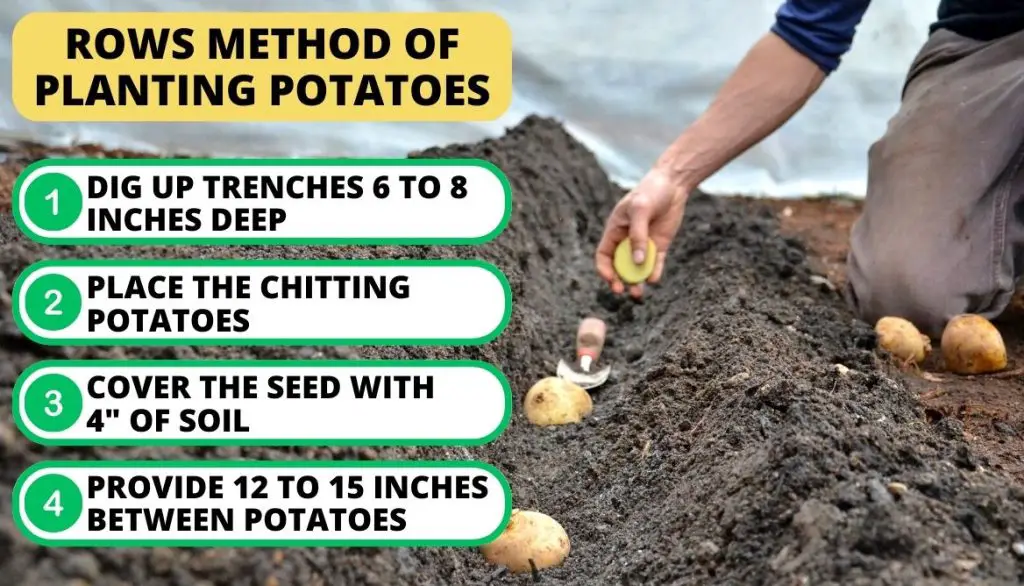
5. Watering the Growing Potatoes
A potato plant will do well in moist areas; thus crucial to keep watering it if you are not farming during a rainy season. Additionally, use well-drained soil to avoid factors like:
- Water logging.
- Rotting due to lack of aeration.
Watering should be done when the smaller potatoes flower sprout as the tubers develop. This stage requires 1 to 2″ of H2O a week for a better time.
6. Harvesting the Mature Potatoes
You have the green light to harvest and enjoy your new potatoes after the foliage turns yellow. Also, stop watering when the latter growing stage ceases. Here are the steps to take when harvesting:
- Dig around the mound of soil to extract the aggressively rooting plants, but leave the smaller potatoes to continue developing.
- If you plan to store the crop after harvesting, leave the potato plant for another 2 weeks until the foliage dies.
- Gently loosen up the root vegetables from the garden using a fork, and allow them to dry if the weather is moist.
- You can also relocate them to a sheltered spot to cure.
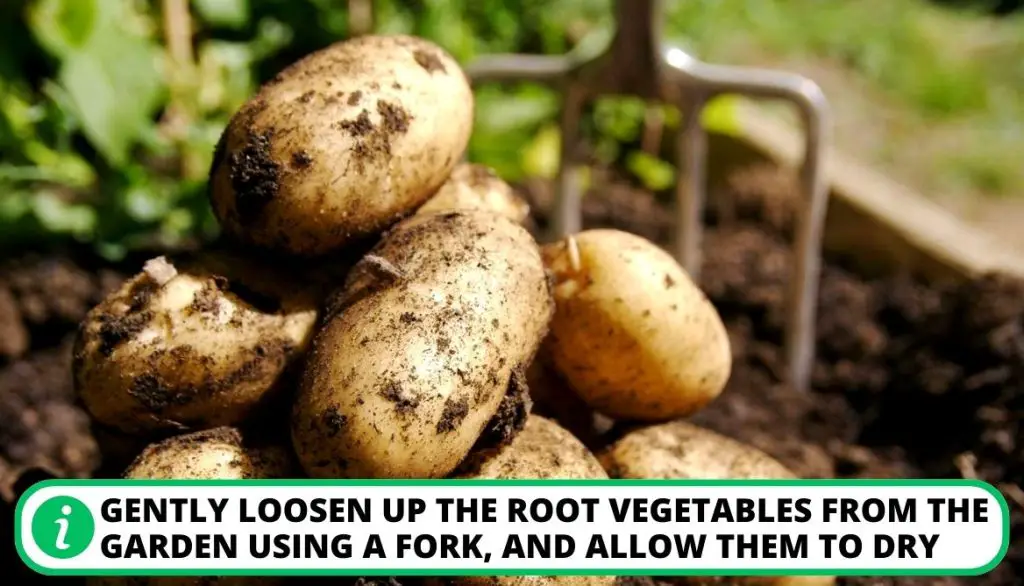
Tips for Planting Potato Eyes
What else can you do to plant seed potatoes? Read on for additional potato farming tips to get around the potato growing season.
- Storing the seeds isn’t a must if you are short on time. You can alternatively cut and plant seed potatoes simultaneously.
- Always divide whole potatoes accordingly if your goal is selling the produce. Smaller equal pieces with eyes will give more output than the full one.
- Treating your seeds is also crucial, where you can use powdered sulfur for dusting purposes. Allow them to dry outside for a period of 3 to 4 days.
- Find a cooler spot to store your seeds when planning to postpone the day of planting. This will allow the sprouts to continue developing without rotting. However, avoid waiting too long, as the potatoes can get dehydrated.
- Plan the proportions for your garden setup to save expenses and time. Usually, 1 lb of seeds should give you up to 10 lbs of output. The same quantity covers up to 5-8 rows.
- You can opt for container and bag farming, allowing you to farm in various weather conditions.
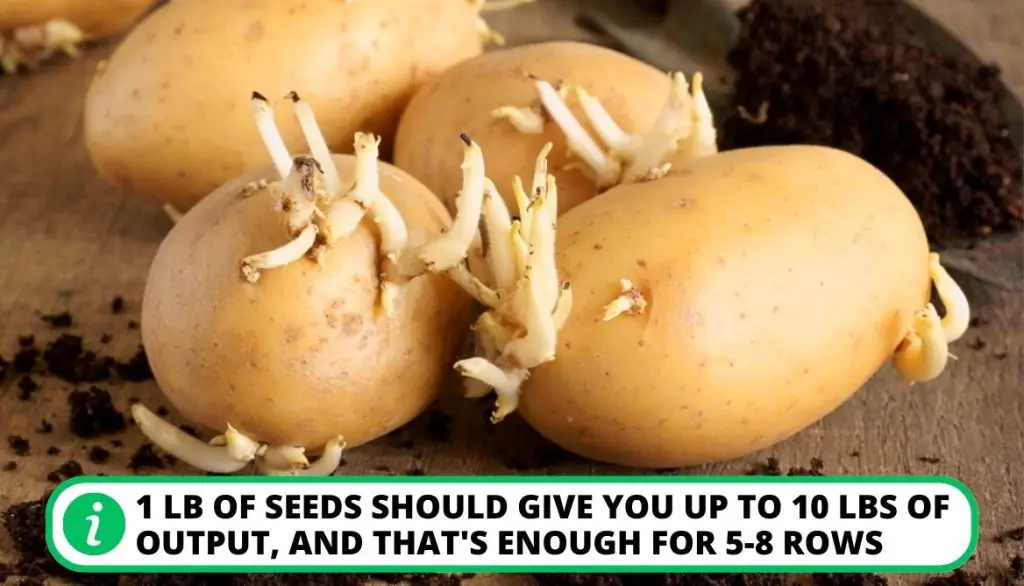
Frequently Asked Questions
What Are The Best Conditions For Planting Potatoes?
The best conditions for planting potatoes include well-drained soil, with temperatures, generally at 45°F at night and 55°F in the daytime, and a pH of 5-7.
How Often Can You Plant Potatoes In The Same Place?
You can plant potatoes in the same place every three to four years.
Can You Plant Potatoes Upside Down?
You can have the plants facing down though it’s not encouraged if you can use the eyes up method.
Conclusion
There you have it regarding how to appropriately plant potato eyes, with ways of dealing with related inconveniences such as changes in temperatures, imbalances of soil composition, and when you want to postpone planting.
It’s best to follow the recommended times between March-June or utilize the right soil conditions when planting. Remember to let your buds fully develop and plant them following the discussed stages to yield more potatoes
So, do you plant your seed potatoes up or down? Comment below with your answer, and let us know each method’s output.
- How to Get Potatoes to Sprout Eyes: Detailed Growing Guide with 3 Options - July 31, 2023
- Weight of a Medium Potato: Revealed in Detailed Guide - July 29, 2023
- Maris Piper Potatoes: 9 Substitutes You Should Know About - July 27, 2023
Hello! I’m Jessica Zander, a garden coach and consultant based in the Boston area (zone 6b), offering virtual consultations across the country and Canada.
I’ve been passionate about gardening since the early 1990s, and in 2022, I launched You Can Do It Gardening to empower individuals to feel more confident in their gardening endeavors.
Following a 30-year career in nonprofit finance and operations, I transitioned out of that field in mid-June of 2023 due to the growing demand for coaching services. Interestingly, my years of presenting financial statements to boards and finance committees proved to be valuable experience for teaching people about gardening! I enjoy sharing skills, providing guidance and suggestions, and collaborating efficiently with clients to make significant improvements to their outdoor spaces, both small and large. I also regularly teach at the Arlington Continuing Education and Cambridge Adult Education.
My approach is direct and practical, akin to Mary Poppins, but tailored to your garden. Clients find satisfaction in saving money and taking pride in their own gardening achievements.

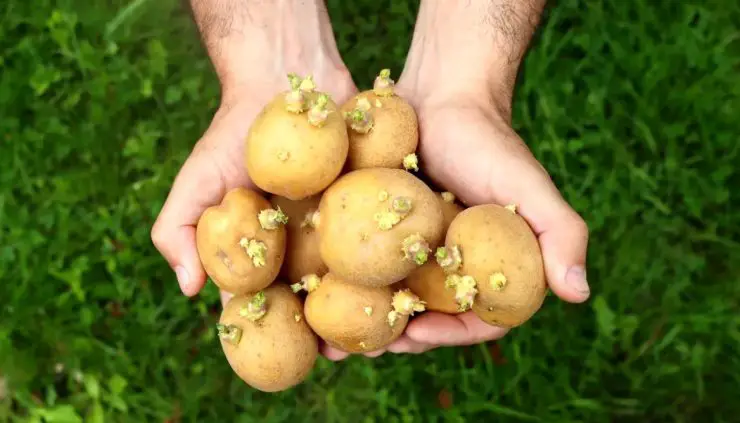

Add comment